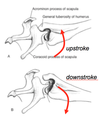Chiroptera Flashcards
calcar
Microchiroptera
- “big toe” on hind feet
- allows bats to spread their patagium
Shoulder locking mechanism in Chiroptera

- extra process (greater tuberocity) fits into scapula
- wing can’t go higher than a certain point on upstroke
- limits upward movement of humerus
- stabilize joint while flying so don’t need to use so much muscle for downstroke
What synapomorphy of Chiroptera allows bats to hang upside down and balance on trees?

- rotation of hip and knee allow bats to hang with ventral surface facing the tree
- modification of elbow
What are the four flight membranes of Chiroptera?

- Plagiopatagium
- Dactylopatagium
- Uropatagium
- Protopatagium
- different flaps of skin provide different functions during flight
- wing membranes made of complex elastic fibers
What makes the Chiroptera premaxilla different from most other mammals?

reduced or absent premaxilla in Chiroptera
What is the major difference between bat and bird flight muscles?

different in layout of muscles
Birds: 2 muscles originate on sternum control wing movement
Bats: many more/more powerful muscles to power down-stroke, smaller muscles power up-stroke
- up-stroke is a recovery stroke = not very energetically expensive
- more control of down-stroke = more maneuverability
- bats are nocturnal + use sound to locate food (short-range foraging) = must be maneuverable
Benefit of reduced forarm muscle size in Chiroptera
- smaller size = less energy needed to control wings
- more elasticity in wings
- important because wings are often deformed while flying
Benefit of asymmetrical wing profile in Chiroptera
- causes unequal pressures above and under wing while flying
- air passes more quickly over bottom part of wing than top = more pressure under wing = LIFT
Thrust and lift
- both necessary to achieve flight
Thrust = forward movement
Lift = stay up in the air
- increases with surface area of wing
Angle of attack and camber

Angle of attack (red): how angled upward wing actually is
- inc. angle of attack = more lift + greater turbulence
Camber (blue) how curved wing is
- inc. camber = inc. curving of wing = inc. lift + inc. drag
General morphology of bat wing
- usually very thin air foils with high camber (very curved)
- sheets of skin between bones deform a lot, very billowy
- rounded wings = high lift, low speeds
- can flex digits to increase wing curvature
- low wing loading (ratio of body weight to wing area)
- low aspect ratio wings (ratio of wingspan to wing breadth
broader wing = more maneuverability = better for short-distance foraging / close spaces / short flight durations
Echolocation
Emission of high frequency sound pulses to discern information about objects in path
- information comes from change in sound from when it left body to when it echos back
Oral emitters = sound comes from mouth (basic nose)
Nasal emitters = sound comes from nose (complex nose to detect returning sounds)
*bats that echolocate tend to have complex facial morphologies
Why can’t low-frequency sound waves be used to detect a small object in a bat’s path?
- low-frequency waves bend around small objects
- to detect something small, must use high-frequency sound waves
How do mammalian ears receive sound?
- Sound pressure waves vibrate tympanic membrane (eardrum)
- Vibrations transfered across middle ear via ossicles
- Vibrations transmitted to inner ear at oval window
- hair cells in cochlea are stimulated by waves and pattern of sound
- hairs transmit nervous signals to brain, which are then decoded into actual sound
*high-frequency vibrations travel further down cochlea
Limitations of echolocation
- sound is attenuated (lost) rapidly in air
- high-frequency sounds absorbed by atmosphere more readily = only useful over short distances
BUT bats need high-freq to detect small prey
Solution: high intensity sounds
Spreading loss vs. absorptive loss
Spreading loss: loss from dissipation of sound away from source
Absorptive loss: sound absorbed by atmosphere
How do bats keep from deafening themselves?
- The tensor tympani and stapedius muscles are well-developed in bats
- help to dampen vibrations of typmanic membrane in the stapes
- automatically activated when sound is being produced
- deactivated when sound is being collected
- The auditory bulla and periotic bones loosely attached to the skull and surrounded by venous sinuses (very large veins) and fatty tissue
- reduce transfer of vibrations from skull
- dampens vibrations to prevent hearing loss
Bandwidth
breadth of frequencies produced
Narrowband = constant frequency CF
- good for target detection but not for pinpointing location of prey
Broadband = frequency modulated FM
- good for pinpointing location of prey
Different types of frequencies for different purposes:
- narrowband calls to detect prey (from farther away)
- switches to broadband FM calls when closing in during attack phase (when getting close)
Echolocation first or flight first?
primitive bats (Onychonycteris finneyi) which could not fly still have some skeletal features of modern, flying bats
- long extended fingers
- calcar on foot
not easy to echolocate without flying; may be able to find food but wouldn’t be able to catch it
- flight probably evolved first
- echolocation probably evolved once and was lost twice in Pteropodidae and Vespertilionoidea
Megachiroptera
- fruit bats
- do not echolocate = echolocation will not tell animal much about fruit, not really useful
- locate food via olfaction and vision
Microchiroptera
- echolocating bats (tragus = helps to capture sound)
Synapomorphies:
- tragus + tightly coiled cochlea
- clavicle articulates with coracoid process of scapula (directly or through ligaments)


